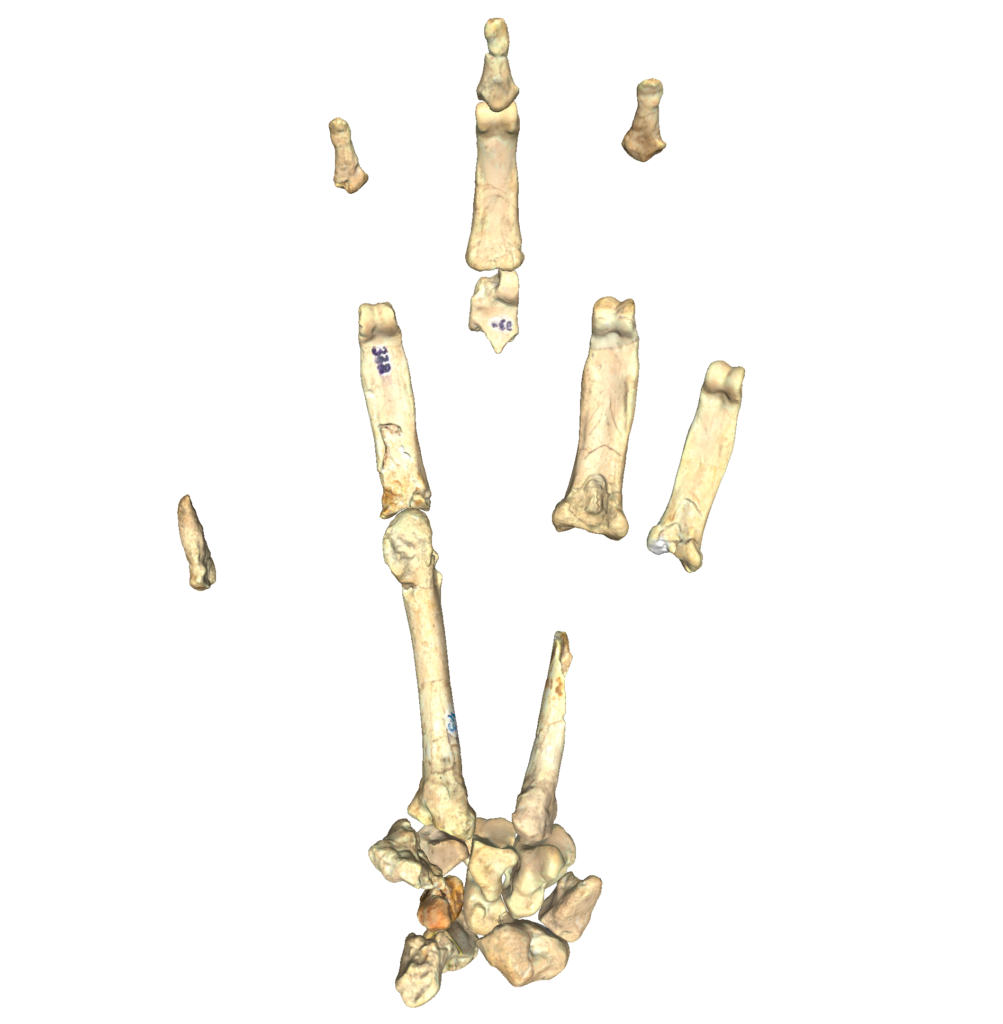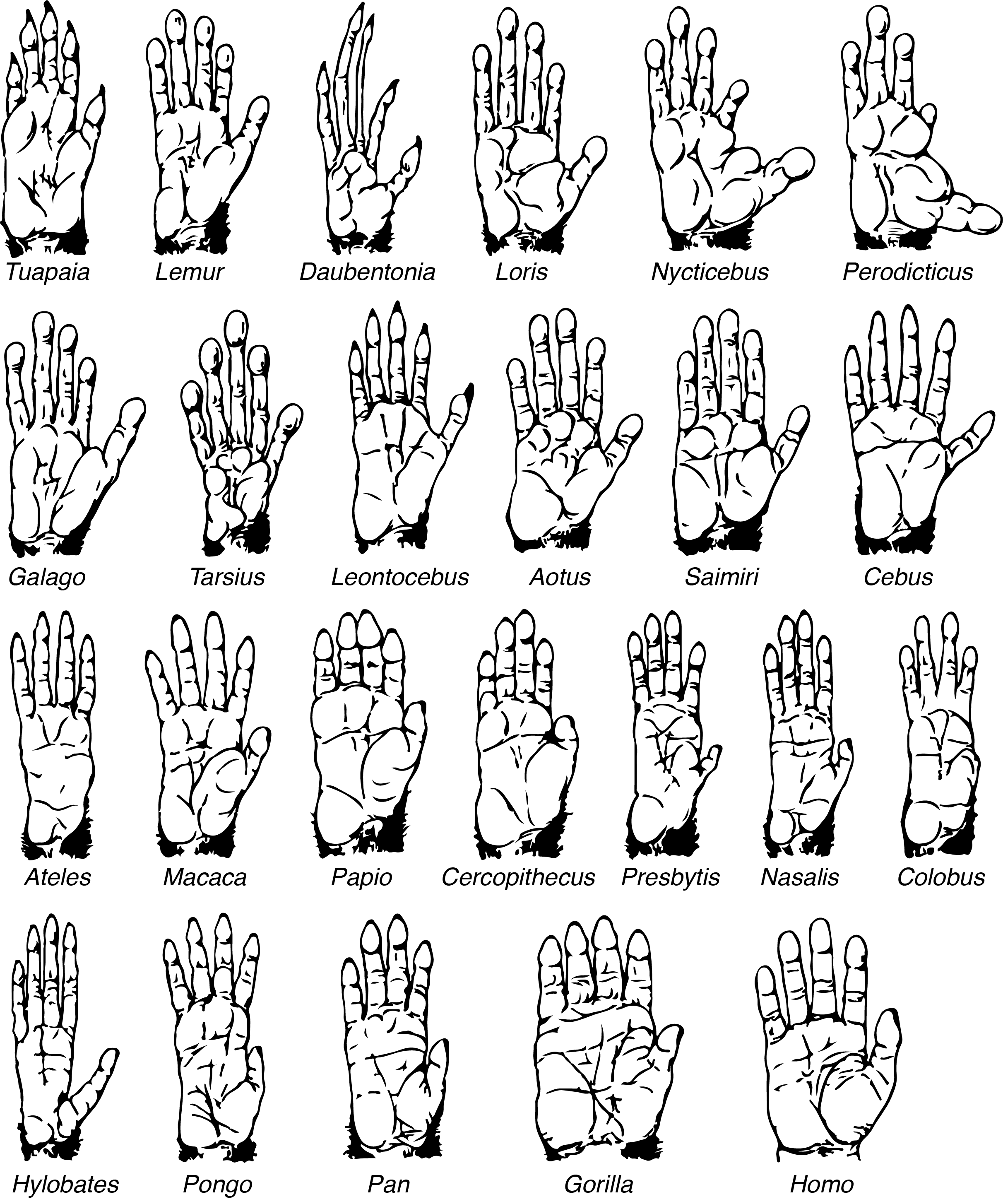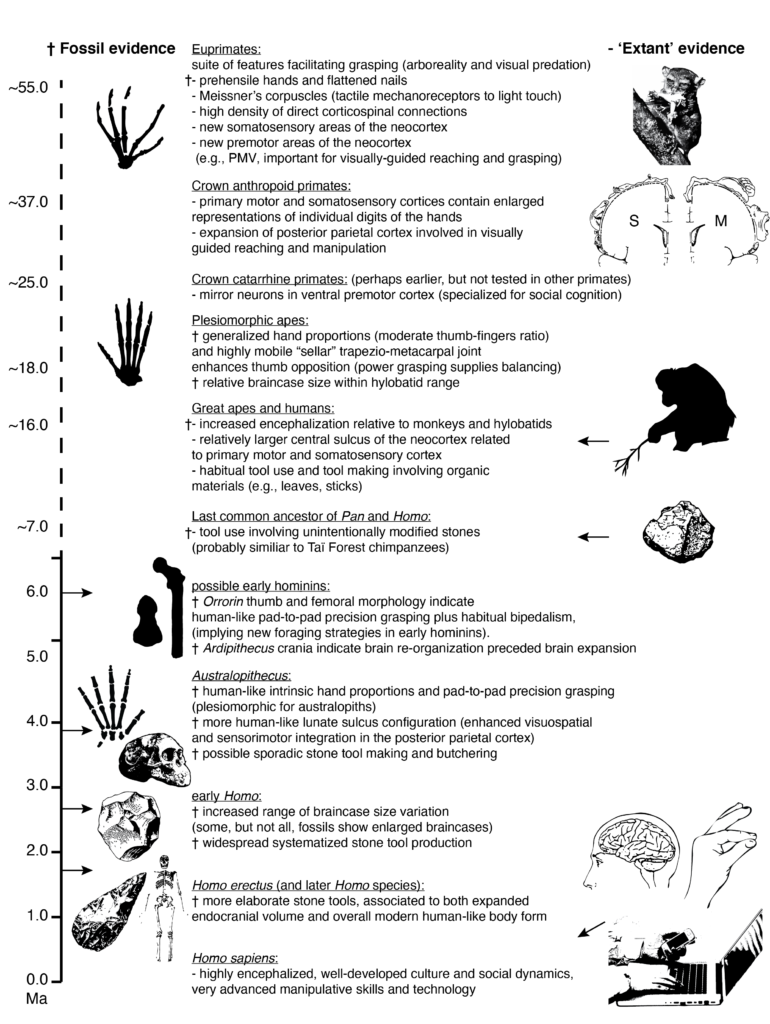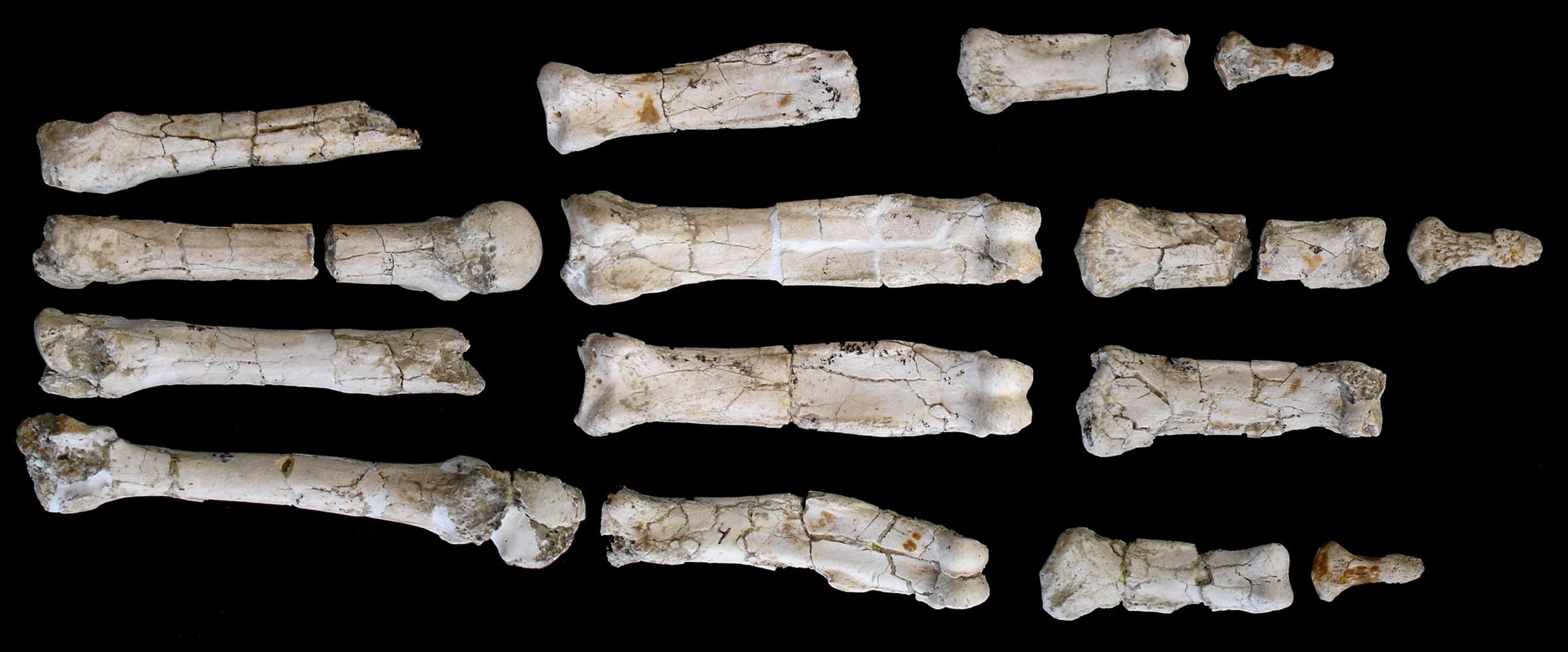Last updated on January 17, 2021
I have been researching the origins of this “uniquely” human structure since 2005. At the time, I had just graduated from college. I spent 10+ hours a day working as a field paleontologist in Els Hostalets de Pierola (near Barcelona), which is well known for its amazing paleontological discoveries. No doubt, the most famous fossil from the area (and likely the entire country) is the partial skeleton of the ~12 million-year-old fossil great ape Pierolapithecus. That year I got lucky: On the one hand, I received a pre-doctoral fellowship from the Catalan government, allowing me to focus on research starting the following year. On the other hand, my now colleagues David Alba and Salvador Moyà-Solà (my future advisor), who directed the work in Els Hostalets, invited me to study the hands of Pierolapithecus and Hispanopithecus (see cover image). The salary was small and the working hours long, but hey, after years of internships and work as a technician, I would become a professional researcher! I was given a unique opportunity, and I wasn’t going to miss it.

The hand of Pierolapithecus. Render image using elements from both sides.
Chimpanzees (including bonobos) are humans’ living closest relatives. Our respective lineages diverged from a last common ancestor (LCA) ~9.3–6.5 Ma. They have smaller brains, shorter thumbs, and much longer digits than humans. A popular working model considers chimpanzees as the “starting point” of human evolution and some extinct members of the human lineage (i.e., fossil “hominins” such as Australopithecus) as overall “transitional” forms between the two. This evolutionary model assumes that living chimpanzees are “living fossils,” closely reflecting the nature of the chimpanzee–human LCA, perhaps even for modern hominoids (i.e., the group that includes apes and humans).

Chimpanzee vs. human hand and brain. The chimpanzee and human hands and brains were redrawn from Figure 27 in Napier, J., 1993. Hands. Princeton University Press, Princeton and Figure 1 in Huble, D.H., 1979. The brain. In: Flanagan, D. (Ed.), The Brain (A Scientific American Book). W H Freeman and Company, San Francisco, pp. 3–10.
Some anatomical regions of these hominins fit the pattern expected with a chimpanzee-like LCA. An example is the increase in endocranial volume (EVC) over time, starting from a chimp-like ECV. The ECV range in early fossil hominins highly overlaps with the range of chimpanzees (Pan) and the other living great apes. However, the assemblage of more recent fossils assigned to the genus Homo (“the human genus”) includes specimens with small and—for the first time—also large ECVs.

Endocranial volume in hominins as compared to chimpanzees. Endocranial volumes (ECVs) for australopiths and their age were taken from different sources. Homo habilis sensu lato includes Homo rudolfensis, and its age range also includes the new mandible from Ledi Geraru (Villmoare et al., 2015). ECVs for H. habilis and Homo erectus after Spoor et al. (2015). Body mass estimates for fossil represent approximate 95% confidence intervals around species means, based on multivariate estimates after Grabowski et al. (2015); Pan troglodytes (chimpanzees) based on own data from museum records; modern humans after Smith and Jungers (1997) based on sex-specific population means (i.e., the actual range is expected to be wider). Ma, mega-annum, or million years ago; Ka, kilo-annum, or a thousand years ago.
Did other aspects of the human body evolve from a chimp-like ancestor? I decided to check this idea for the case of the hand. Why the hand? Current debates relating to the chimpanzee-human LCA’s hand morphology are fueled by competing inferences regarding this ancestor’s locomotor repertoire. For example, was the LCA a knuckle walker like chimpanzees and gorillas? Was it “suspensory,” hanging below the tree branches? Hints about the locomotion of chimpanzee-human LCA can be found in the hand of living and extinct species.
Primate hands are made for grasping. Even more, primates benefit from prehensile hands (i.e., one-hand grasping), whereas most other mammals need both hands to hold objects (imagine a squirrel chewing on a nut). The primate hand anatomy reflects a compromise between locomotion and manipulation. Apes use forceful “power grips” habitually, humans too (e.g., visualize yourself using a hammer). However, living apes are more limited in their “precision grips.” Now imagine yourself throwing darts. That’s a “pad-to-pad” precision grip. Chimpanzees (like the other living apes) can’t do it because their fingers are too long relative to their thumbs. However, modern apes are better suited to move in the tree canopy. Hence, a popular notion in human evolution is that our fingers became shorter and our thumbs longer to manipulate objects better and make stone tools. Subsequently, the story goes that handy skills and bigger brains (associated with enhanced cognition ever more sophisticated technology) went hand-by-hand.

Power and precision grips. Human hand performing power (top) and precision (middle) grips. Chimpanzee hand holding a small object using precision grip (bottom). Note the length and robusticity of the human thumb relative to the other fingers. In comparison, chimpanzees show elongated fingers relative to the thumb. Extant great apes are not capacitated with a humanlike pad-to-pad precision grip (middle) due to the disproportion in length between the thumb and the fingers. However, other kinds of precision grip are possible (bottom). The top two panels are drawn after Figures 28a and 24 in Napier, J., 1993. Hands. Princeton University Press, Princeton. The bottom panel is redrawn based on Figure 6 in Christel, M., 1993. Grasping techniques and hand preferences in Hominoidea. In: Preuschoft, H., Chivers, D.J. (Eds.), Hands of Primates. Springer, Wien, pp. 91–108. Images are not to scale.
Over the years, I joined forces with colleagues from all over the world to have a new look at old fossils. To understand the roots of the human hand and check if the human hand originated from a chimpanzee-like hand, we needed to compare the hand anatomy of early hominins with that of fossil apes pre-dating the times of the LCA. Our findings could surprise many: After many morphometric analyses and phylogenetically-informed comparisons, my colleagues and I found that the hand proportions of early hominins (e.g., Ardipithecus, ~4.4 Ma) are not substantially different from some fossil apes pre-dating the ape-human split (e.g., Ekembo, ~18 Ma; Pierolapithecus, ~12 Ma).
Our results suggest that the similarities among the hands of living apes are only apparent. Likely, the digits became long independently in chimpanzees, orangutans, and gibbons/siamangs (in this increasing length order) from the moderate proportions reconstructed for the great ape-human and chimpanzee-human LCAs. Furthermore, each of these apes achieved their current hand looks through different means. For example, whereas chimpanzees mostly elongated their metacarpals (the long bones of the palm), orangutans also elongated their phalanges (as well as their forelimb long bones). By comparison, the thumb length hasn’t changed as much. Interestingly, the human hand is not that different from that of gorillas when size differences are considered. Both show a similar degree of slight digital reduction relative to our great ape ancestor (our thumb became a bit elongated, too). Why would long fingers evolve several times in different apes? Actually, long and highly curved fingers are known to have arisen independently in other primates as well (e.g., spider monkeys, sloth lemurs). These primates have one thing in common: specific adaptations to suspend below the tree branches.
Others reached similar conclusions decades ago in the absence of the fossils and advanced numerical methods that we have today (e.g., Adolph Schultz, William Straus, Louis Leakey, John Napier). These authors noticed that, in its overall proportions, the human hand is more similar to that of many anthropoid primates than to the long hand of most living apes. Although subsequent advances in genetics, indicating humans’ closest relationships with chimpanzees, turned things around.

The hands of primates. As compared to other living hominoids (last row), humans (Homo) exhibit a long thumb relative to the digits, facilitating precision grasping. It is important noticing that: first, the structure of the human hand is highly conservative among primates (e.g., prehensile capabilities, five digits); and second, in terms of overall intrinsic proportions, although at first sight, it might seem an outlier among hominoids, its overall proportions do not differ substantially from many other non-hominoid anthropoid primates (second and third rows except Galago and Tarsius). The most arboreal anthropoids (e.g., Ateles, Presbytis, Nasalis, Colobus, Hylobatids, Pongo, Pan) tend to have longer digits relative to the thumb. In some cases, the thumb is even absent! The figure is redrawn after Figure 5 in Schultz, A., 1968. Form und funktion der primatenhände. In: Rentsch, B. (Ed.), Handgebrauch und Verständigung bei Affen und Frühmenschen, pp. 9–30. Hands are not to scale.
Incorporating more fossils into phylogenetically-informed evolutionary modeling allows us to bring a more accurate fourth dimension into the equation. Fossils help us understand the complex—mosaic—patterns of evolution. It seems that homoplasy (i.e., “false homology” caused by processes such as parallelism and convergences) could be the rule, rather than the exception, in ape and human evolution. The implication is that we should be cautious when reconstructing evolutionary scenarios that rely exclusively on living species as ancestral models.
It turns out that in its overall proportions, the human hand is quite primitive. Some aspects of its anatomy, such as more robust finger joints and thumbs, evolved more recently (~2 Ma) and could be specifically adapted to using and making stone tools. However, it is likely that when hominins started to systematically flake tools out of stone cores (~3-2 Ma), their hands were already prepared for the task. At least, that’s what I think based on Orrorin, a 6-million-year-old hominin capacitated with a human-like precision grip. Why and how would adaptations for enhanced manipulation evolve millions of years before purposive stone tool making did? I think that the strange way we move around has something to do with it.

Timeline showing major advents in human evolution related to manipulative capabilities. The primate fossil record and comparative biology indicate that the story of human advanced manipulation has very early origins, predating the widespread appearance of systematized flaked stone tool manufacture. Ma, million years ago. Euprimate hand outline after the reconstructed Notharctus tenebrosus (AMNH 127167) from Boyer et al. (2013). The age of appearance of crown groups is based on the fossil record after Stevens et al. (2013).
Thanks to Salvador Moyà-Solà, David Alba, Masato Nakatsukasa, Randy Susman, Bill Jungers, Matt Tocheri, Tracy Kivell, Biren Patel, Caley Orr, Marvin Shrewsbury, and the late Mary Marzke, for their passionate discussions about the origins of the human hand. Especial thanks to the late John Napier, a mentor that I never met.
Clip about my research on the evolution of the human hand
It’s part of the documentary “The Secret History of our Evolution” by Pierre-François Gaudry. Watch the entire documentary, it’s fascinating.
Some of my research articles about the human hand:
- The evolution of human and ape hand proportions
- Hands, brains, and precision grips: Origins of tool behaviors
- Earliest modern human-like hand bone from a new >1.84-million-year-old site at Olduvai in Tanzania
- Early origin for human-like precision grasping: A comparative study of pollical distal phalanges in fossil hominins
News related to this research (selected):
- Hands hold clues to primate evolution
- Humans have more primitive hands than chimpanzees
- Earliest human hand bone unearthed in Africa
